The ideal time to visit Vietnam is between November and April when you’ll enjoy dry weather and comfortable temperatures across all regions. You can explore the temperate north, central beaches, and tropical south without worrying about monsoon rains or extreme heat. While the south stays consistently warm, the north offers invigoratingly cool winters. December to February brings peak tourist season, but March and April offer fewer crowds with equally agreeable conditions. Our complete seasonal guide explores the nuances of each region’s unique climate patterns.
Key Takeaways
- November to April offers optimal weather conditions countrywide, with lower rainfall and comfortable temperatures for exploring all regions.
- Avoid the central coast from August to November due to severe typhoon risks and potential travel disruptions.
- March-April and September-October are ideal shoulder seasons with good weather and fewer tourists throughout Vietnam.
- Southern Vietnam is best visited during the dry season (November-April) when rainfall is minimal and temperatures remain stable.
- Northern Vietnam offers excellent trekking opportunities from September to November with mild temperatures and clearer skies.
Seasonal Weather Patterns Across Vietnam’s Regions
Vietnam’s weather patterns divide naturally into three distinct climate zones: the tropical south, the monsoon-influenced central region, and the more temperate north.
You’ll find the most dramatic seasonal temperature fluctuations in the mountainous northern region, where winters can be surprisingly cool and foggy while summers bring heat and humidity. The central region experiences intense monsoon rains, particularly from September to December, creating a unique rhythm to travel planning. The south maintains a more consistent tropical climate year-round, with a wet season running roughly from May to November. Most areas maintain average humidity levels of 85% throughout the year.
For a respite from the heat, consider exploring highland climate variations in places like Dalat in the central highlands, where the elevation provides cooler temperatures throughout the year. Each region’s distinct weather patterns create opportunities and challenges for travelers, so timing your visit to align with your preferred climate conditions is essential.
Peak Tourist Seasons and What to Expect
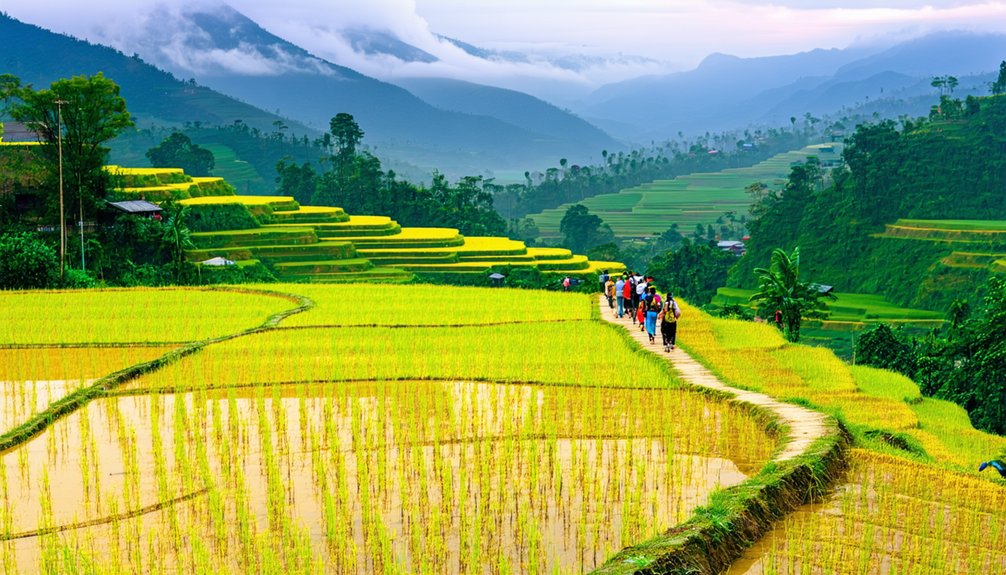
Understanding Vietnam’s seasonal rhythms helps you plan around tourist flows that shape your travel experience. The main tourist surge hits from October through April, drawing international visitors seeking dry, pleasant weather across the country. You’ll encounter peak season crowds and steeper prices during this stretch, with accommodation costs climbing 30-50% above normal rates.
A second wave of visitors floods coastal hotspots like Da Nang and Phu Quoc during July and August when beach conditions are ideal. The Lunar New Year (Tet) festival triggers another spike in domestic travel, meaning you’ll compete with locals for space and services. Cultural attractions and traditions draw massive crowds during the winter peak season. If you’re seeking better shoulder season pricing, consider visiting coastal regions in May or September when crowds thin out but weather remains favorable. Northern highlands offer a unique spring spectacle in March and April as flowers bloom, though you’ll want to avoid the central coast’s typhoon season from July through October.
Northern Vietnam’s Climate Guide
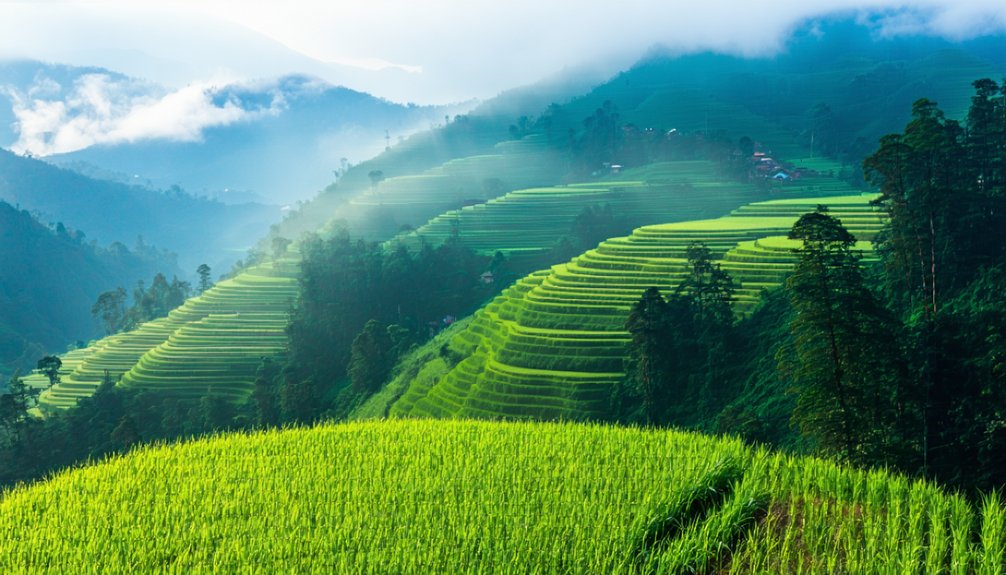
A complex interplay of monsoons and topography shapes Northern Vietnam’s dramatic four-season climate. You’ll experience distinct shifts throughout the year, from chilly winters with temperatures dropping to 6°C to sweltering summers reaching beyond 35°C. The region’s diversity means you’ll need to pack strategically – layer your clothing for the spring and autumn shoulder seasons, while winter demands thermal wear, especially if you’re heading to highland areas like Sapa. The humid subtropical climate creates unique challenges and opportunities for visitors throughout the year.
For photographers, autumn offers the most rewarding conditions, with clear skies illuminating golden rice terraces and comfortable temperatures around 24-30°C. Spring brings vibrant flower festivals and moderate warmth, though you’ll want quick-dry gear for occasional drizzles. Summer’s intense heat and monsoon rains can challenge both comfort and camera work, while winter’s persistent fog creates ethereal scenes but requires patience and specialized photography techniques, particularly along the northeast coast and in Ha Long Bay.
Central Vietnam’s Weather Calendar
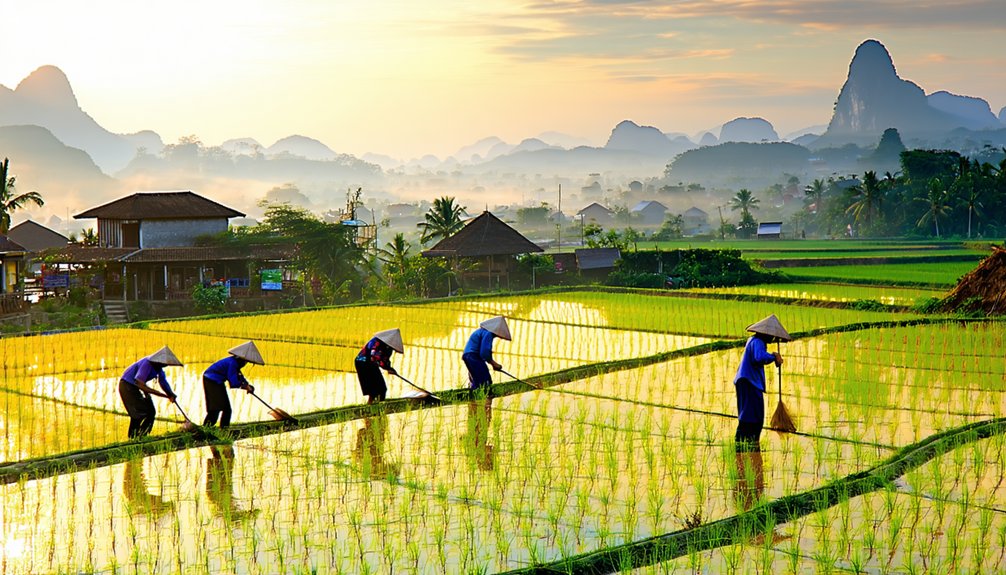
While most tropical destinations follow simple wet-dry patterns, Central Vietnam’s weather demands careful planning due to its unique regional variations and monsoon influences. You’ll encounter dramatic temperature fluctuations across regions, from the winter chills of Hue to the consistent warmth of Da Nang and Nha Trang.
February through July offers your best window for coastal exploration, with temperatures hovering between 28-32°C and minimal rainfall. You’re free to enjoy pristine beaches and water activities during these months. The months provide excellent beach conditions with clear blue skies and low humidity. However, watch for rainfall intensity variations as you move south – Hue receives twice the annual rainfall of Nha Trang. August kicks off the storm season, bringing potential travel disruptions until January, especially in flood-prone areas like Hoi An. The Central Highlands march to their own beat, with pleasant daytime temperatures but significant nighttime cooling during the dry season, perfect for adventurous trekking between December and May.
Southern Vietnam’s Tropical Rhythms
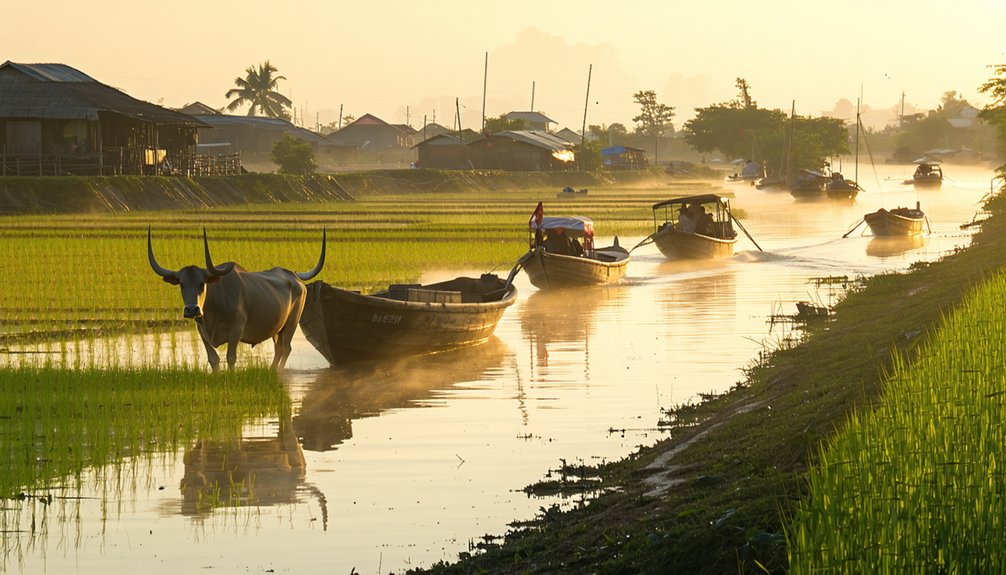
Unlike Central Vietnam’s distinct weather shifts, you’ll find Southern Vietnam maintains remarkably stable temperatures year-round, hovering around 30°C with minimal seasonal fluctuations. You’ll experience two clear-cut seasons: a dry period from November through April that’s ideal for exploration, and a wet season from May to October characterized by dramatic afternoon downpours. During the rainy season, expect 2-3 days of rain each week. The mighty Mekong Delta adds its own weather dynamics to the mix, where annual flooding patterns and tidal influences create unique considerations for travelers, particularly during the peak rainy months of July and August.
Stable Year-Round Temperatures
Southern Vietnam’s consistently warm temperatures make travel planning remarkably straightforward throughout the year. You’ll find comfortable consistent temperature ranges hovering between 25-35°C (77-95°F), with coastal areas maintaining a pleasant 27°C (81°F) average. This year-round comfort means you won’t need to pack for dramatic weather shifts.
The region’s stability is particularly evident in Ho Chi Minh City, where monthly averages fluctuate minimally between 26-29.2°C (79-85°F). Even during January, the coolest month, nighttime temperatures rarely dip below 22°C (72°F). During the day, you can expect highs between 30-33°C (86-91°F), creating ideal conditions for exploring without extreme temperature concerns. This predictable climate pattern lets you focus on your adventures rather than worrying about weather variations. The warmest period occurs when maritime tropical air masses dominate during the summer months.
Wet Vs Dry Patterns
The predictable warmth in Vietnam’s south pairs with distinct wet and dry seasons that shape the region’s character. You’ll experience dual monsoon patterns with a lengthy dry stretch from November through April, when rain chances dip below 10% daily. The wet season dominates May to October, peaking mid-summer with dramatic afternoon downpours lasting about an hour. Temperatures range 25-35°C throughout all seasons, maintaining a consistent tropical feel.
Watch for transitory shoulder periods in April/May and October/November, when weather patterns can shift erratically. During the pinnacle of the wet season, you’ll encounter rainfall 15-20 days monthly, with Ho Chi Minh City receiving nearly 300mm in October compared to just 12mm in January. Despite the monsoon’s intensity, coastal areas like Phu Quoc and Con Dao maintain surprisingly sunny conditions, with clear skies prevailing 80% of the time even during wet months.
Mekong Delta Weather Dynamics
Nestled along Vietnam’s southern edge, the Mekong Delta pulses with a tropical rhythm that’s defined by its distinct two-season climate. You’ll experience yearly temperatures ranging from 72°F to 95°F, with the region rarely cooling below 72°F even at night. Afternoon thunderstorms occur frequently during the wet months, creating dramatic displays across the delta landscape.
The delta’s rainfall patterns split dramatically between wet and dry seasons. While you’ll find October drenched in nearly 10 inches of rain, February barely registers 0.2 inches. These patterns considerably impact the delta ecosystem, with saltwater intrusion affecting 40% of farmland. Climate change is intensifying these extremes – you’re looking at potentially 25% more wet-season rainfall versus much drier dry seasons by 2100. For the most comfortable exploration, target November through April, when you can enjoy the floating markets and cycling tours under clearer skies.
Cultural Festivals and Weather Impact
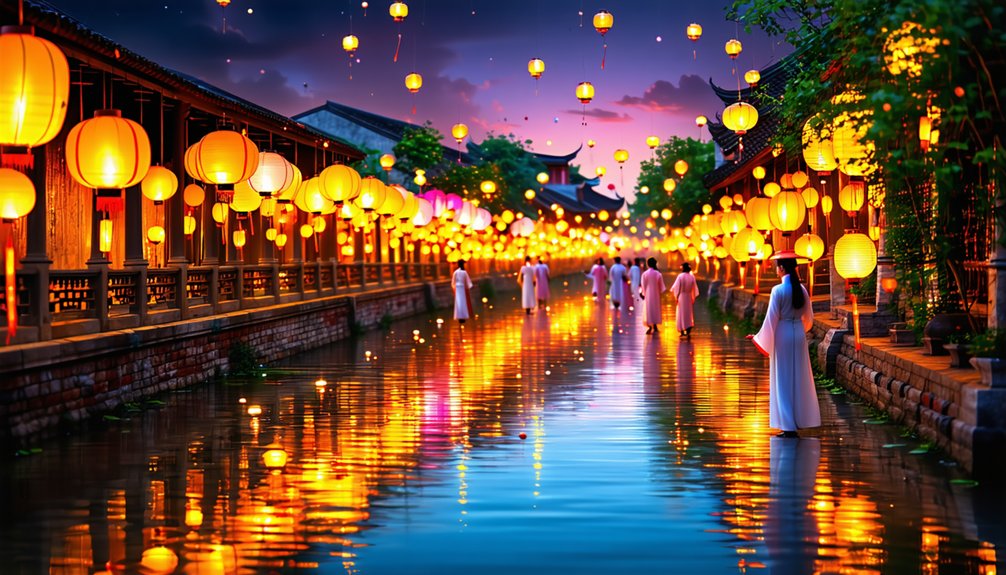
Planning your visit around Vietnam’s vibrant festivals requires careful consideration of the country’s diverse weather patterns. You’ll find the most favorable festival crowd dynamics during January through April, when temperatures remain moderate and rainfall is minimal nationwide. This period coincides with major celebrations like Tet Nguyen Dan and the Hue Festival.
Festival scheduling considerations vary substantially by region. While you’re free to explore northern festivals during spring’s mild weather, you’ll want to avoid central Vietnam’s typhoon season from August to November, which can disrupt coastal celebrations. The Perfume Pagoda Festival draws thousands of pilgrims to Hanoi between February and May for Buddhist ceremonies and scenic boat rides. The south’s tropical climate means you can enjoy year-round festivals, though monsoon showers from June to November might affect outdoor events. For the most comfortable experience, target the December to May dry season in the south, when you’ll find clear skies perfect for festivities like urban Christmas celebrations and traditional Khmer observances.
Beach Destinations by Season
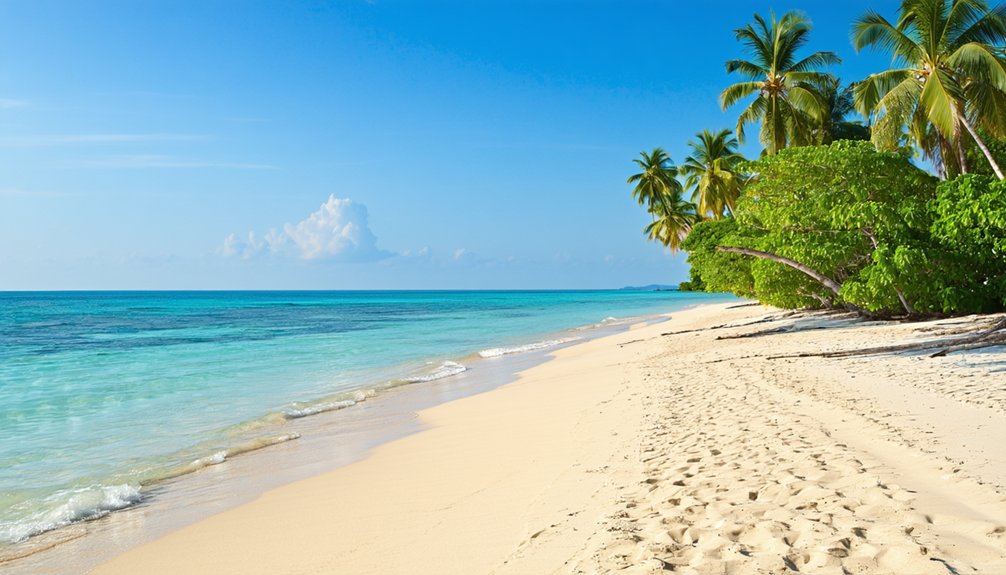
While Vietnam’s coastline stretches over 2,000 miles, you’ll find each beach region has its own distinct high season for ideal visits. The central beaches, including family-friendly beach resorts in Danang and Hoi An, shine brightest from April through August, offering perfect swimming conditions and clear skies. You’ll want to explore romantic beach getaways in southern destinations like Phu Quoc and Mui Ne from November to April, when the waters are calmest and sunshine is abundant. The southwest monsoon protection from the Truong Son mountains helps keep central beaches enjoyable even during challenging weather elsewhere.
For central Vietnam, avoid October through December when typhoons can disrupt your beach plans. Nha Trang peaks from February to May, with its dry season extending through August. Northern beaches near Halong Bay are best experienced in October and November, though Cat Ba Island offers quieter moments during off-peak seasons. If you’re heading to Con Dao or Phu Quoc, they’re accessible year-round, but expect brief afternoon showers outside the November-April dry season.
Trekking and Adventure Timing
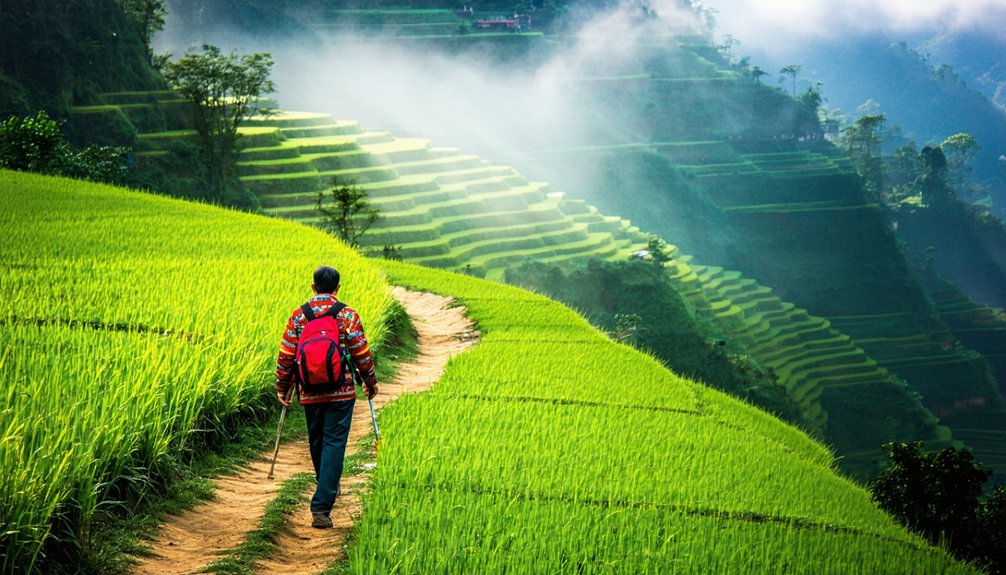
Vietnam’s diverse landscapes offer trekking experiences far beyond its beautiful beaches, with each region presenting distinct prime seasons for adventure. You’ll find ideal multi-day trekking conditions in the north from September through November, when temperatures hover between 15-25°C and trails remain dry yet surrounded by lush vegetation. In the northern regions, September offers the special sight of golden ripe terraces cascading down mountainsides.
For wildlife encounters, plan your trek during December through March in southern regions like Cat Tien National Park, when cooler temperatures draw animals into more visible areas. If you’re eyeing the iconic Fansipan Mountain, October through December delivers clear skies and comfortable hiking conditions. You’ll dodge peak crowds by targeting shoulder seasons (September-November, March-April), when prices drop by 30% and trails are less congested. Consider timing your adventure to coincide with local festivals, like the Mid-Autumn celebrations in Sapa, where night treks offer unique cultural immersion opportunities.
Avoiding Natural Hazards and Extreme Weather
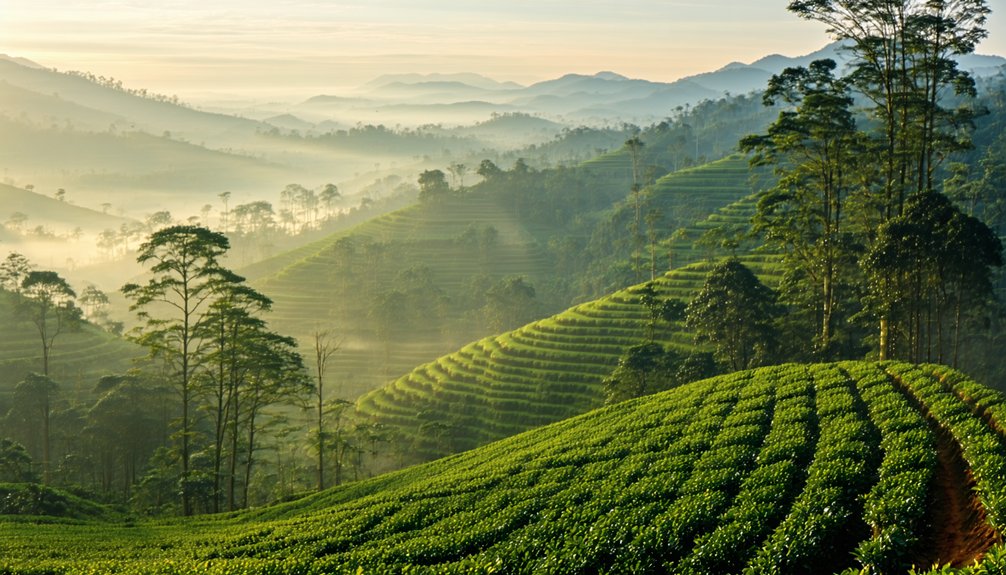
When planning your Vietnam adventure, you’ll need to carefully consider the country’s distinct natural hazards and weather patterns that vary by region. The central coast faces severe typhoon risks from August to November with potential flooding up to 1.5m deep, while the northern mountains experience dangerous landslides during May-October rains. Southern Vietnam’s monsoon season brings urban flooding and occasional tornadoes from June to November, making December through April the safest period for most travelers. Cities like Da Nang and Quang Nam are at highest risk level for flooding during monsoon season.
Typhoon and Flood Seasons
To stay safe during your Vietnam travels, you’ll need to carefully plan around the country’s intense typhoon season, which runs from May through November. Northern regions like Halong Bay face peak risks during August-September, while central areas near Da Nang remain vulnerable through January.
Stay informed through Vietnam’s typhoon forecasting systems and embassy alerts, particularly when visiting coastal destinations. Risk mitigation strategies include avoiding island excursions during storm peaks and rescheduling mountain treks if landslide warnings are active. The devastating impact of recent storms required 1.3 million evacuations during Typhoon Molave alone. The Mekong Delta experiences prolonged flooding May-November, while urban centers like Hanoi face flash flood risks during heavy rainfall. Recent storms like Typhoon Yagi have caused billions in damage and hundreds of casualties, so timing your visit outside peak season considerably reduces weather-related travel disruptions.
Mountain Safety Precautions
Traversing Vietnam’s mountainous regions demands careful preparation and awareness of multiple natural hazards. You’ll need to implement landslide mitigation strategies by avoiding treks during heavy rainfall and monitoring ground stability. For wildlife encounter prevention, use permethrin-treated clothing and maintain safe distances from local fauna, particularly in areas known for venomous snakes and primates. Experienced companions are essential for first-time climbers to safely navigate challenging terrain and receive guidance on safety protocols.
- Pack thermal layers and emergency blankets for temperatures below 10°C in northern highlands
- Choose certified guides for challenging routes like Sapa and Ha Giang loop treks
- Carry hiking poles and GPS devices; avoid relying on tree branches for support
- Report any signs of forest fires immediately, especially during dry seasons
- Use headlamps for visibility and share your itinerary with local contacts
Heat and Humidity Risks
Vietnam’s oppressive combination of heat and humidity presents vital health risks that you’ll need to carefully manage during your visit. With national humidity averaging 84% and temperatures soaring above 100°F in both northern and southern regions, heat index considerations become essential for your safety and comfort.
You’ll face the most challenging humidity fluctuations in Hue, where December levels reach 87.3%, while southern cities experience intense heat during the dry season from November to April. To protect yourself, avoid outdoor activities during peak hours (10 AM to 4 PM), stay hydrated, and seek air-conditioned spaces when possible. The risk is particularly high in northern summers and southern dry seasons, where the heat index can make temperatures feel extremely hotter than actual readings suggest. Being mindful of weather patterns is crucial since Vietnam experiences 6 to 7 typhoons annually, which can significantly impact travel conditions.
Month-by-Month Travel Planning
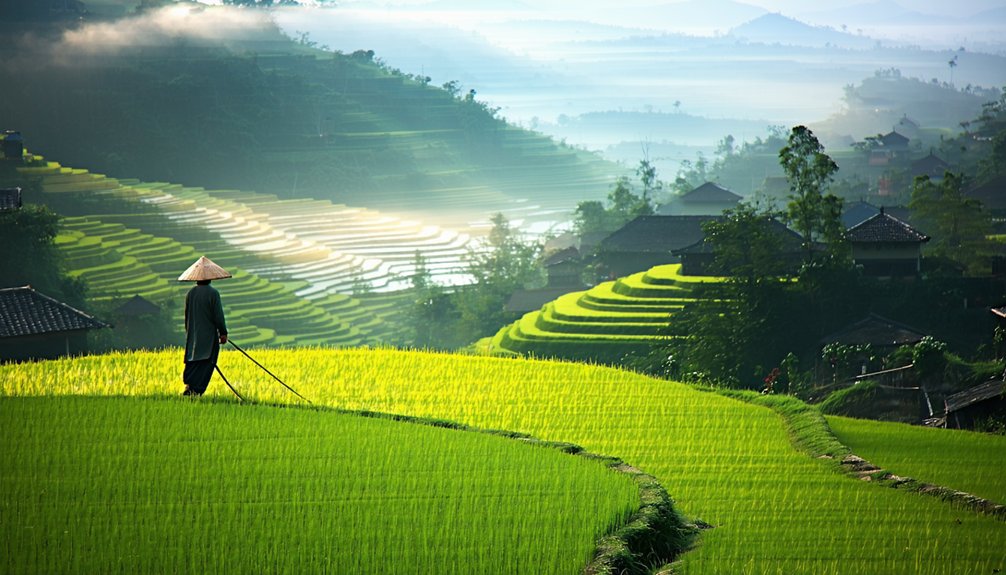
Planning your Vietnam adventure requires careful consideration of seasonal patterns that vary dramatically across the country’s diverse regions. While the south maintains relatively stable temperatures year-round, the north experiences distinct seasons that can enormously impact your travel experience. The Mid-Autumn Festival occurs during the full moon between September and October, offering visitors a chance to experience one of Vietnam’s most cherished cultural celebrations. Vital travel periods shift depending on your intended destinations, with regional travel considerations playing a critical role in timing your visit.
Vietnam’s diverse climate zones demand strategic travel planning, as weather patterns vary significantly between its northern and southern regions.
- November to April offers ideal conditions for exploring the entire country, with minimal rainfall and moderate temperatures
- March and April provide perfect weather for beach destinations like Phu Quoc and Nha Trang
- The Tet Festival (Vietnamese New Year) in late January or early February brings unique cultural experiences but expect increased prices and crowds
- September to December presents excellent opportunities for trekking in Sapa and exploring Ha Long Bay
- The shoulder seasons of March-April and September-October often provide the best balance of good weather and fewer tourists
Remember to match your itinerary with local weather patterns to maximize your Vietnam experience.





